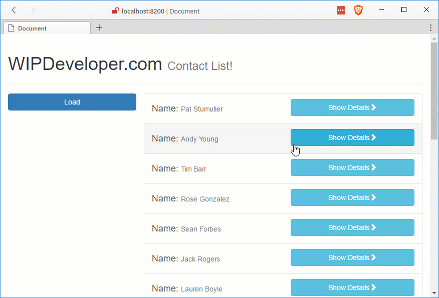Using ForceJS with Vue.js - Part V - Dynamic URLs and Editing Objects
Brett M. Nelson - Wednesday, March 22, 2017
Last time we set up an event hub so we could pass events between components and since we already did the set up, queried Salesforce.com using ForceJS and ForceSever with Vue.js and created a reuseable service lets add an update feature to the service and to update our contacts and through in some routing with route parameters.
Add Link to edit-contact
We will add routing to our app very similar to how we added in Quick Look @ Vue.js Part V - Adding Routing except this time we will also pass a parameter in the url.
Lets start by adding a router-link in our contactDetail near the end of the template:
Add router-link
<h4 class="col-xs-12">
<router-link v-bind:to="{ name: 'editcontact', params: { id: currentContact.Id } }" class="btn btn-warning btn-block">Edit</router-link>
</h4>
Maybe you noticed that for the to attribute we used what looked like a JavaScript object that's because it was. The router-link will use this object to build the url route to a named route with a parameter. This of course means we need to have a route that is named.
Add Routes with Names
In our app.js lets create a router with the following paths:
app/app.js router
var routes = [
{
path: '/',
component: contactsVM
},
{
name: 'editcontact',
path: '/editcontact/:id',
component: editContactVM,
props: true
}
]
Don't forget to register it with the app and add
<router-view></router-view>in place of your<contacts></contacts>on theindex.html
In the second route you see we also provided a name attribute. This will allow the link we made in our contactDetail to generate the path based on the name.
The path itself has an interesting feature of :id. This means that this section of the path is a parameters named id.
You'll also see we added an attribute of props and set it to true. These means that the components props values will be set with the url parameters, in this case id.
Another New Component
We will now need a the component we just registered with our routes so lets create one in and add a reference to in on index.html before the app.js reference.
app/components/edit-contact.js
let editContactVM = Vue.component('edit-contact', {
props: ['id'],
template: `
<div>
<div class="row" v-if="loading">
<h4 class="col-xs-12">
Loading, please wait...
</h4>
</div>
<div class="row" v-if="currentContact">
<h4 class="col-xs-12">
Name: <small></small>
</h4>
<h4 class="col-xs-12">
Languages: <input v-model="currentContact.Languages__c" placeholder="Languages" />
</h4>
<div class="col-xs-6">
<router-link to="/" class="btn btn-danger btn-block">Cancel</router-link>
</div>
<div class="col-xs-6">
<button v-on:click="saveContact()" class="btn btn-success btn-block">Save</button>
</div>
</div>
</div>
`,
data: () => {
return {
currentContact: null,
loading: false
}
},
created: function () {
this.loadContact()
},
watch: {
'$route': 'loadContact'
},
methods: {
loadContact: function () {
this.loading = true
this.currentContact = null
sfService.query(`SELECT Id, Name, Languages__c FROM Contact WHERE Id = '${this.id}'`)
.then(response => {
this.currentContact = response.records[0]
this.loading = false
})
},
saveContact: function () {
let toUpdate = {
Id: this.currentContact.Id,
Languages__c: this.currentContact.Languages__c
}
sfService.update('contact', toUpdate)
.then(() => {
router.push('/')
})
}
}
})
This new component has a props of id so that the router can set that value from the url parameters. It also has a method names saveContact that uses sfService.update so we should probably add that before we run the app.
Add an Update
In our sf.service.js lets add a new function after the query public function:
app/services/sf.service.js's New update function
function update (objectName, value) {
return getDataService()
.then(dataService => {
return dataService.update(objectName, value)
})
}
We will also need to expose it through our return object:
app/services/sf.service.js's Updated return Object
return {
query: query,
update: update
}
Run It
Now we should be able to run it and edit the Languages__c of our contacts:
Editing Languages

Conclusion
Now that we can edit contacts maybe we should add in the ability to create new contacts altogether. What do you think? Let me know by leaving a comment below or emailing brett@wipdeveloper.com.